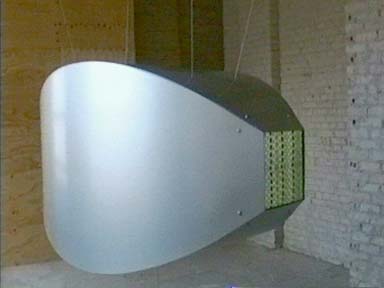|
video
installation
INTRODUCTION
The main constituent of the installation is a film (5’ 56’’
in duration) which loops endlessly on a video monitor. This is viewed
through a large-format rectangular kaleidoscope which reflects the video
images endlessly in all directions. The whole is housed in a silver
casing which hangs in space at eye-level.
OVERVIEW
The video itself concerns itself with reactions to and reflections on
the city-image which is currently being marketed as “the new Berlin“.
Berlin is the ideal basis for this work because as an example of a city
recreating itself, it is unparalleled in Europe in its scope and speed.
The content has, however, relevance for every major city.
The surface level of this new city-image is pervaded by one notable
principle - the repetition of the unit. Facades are constructed by taking
one basic window element and repeating it to the left, to the right,
upwards and downwards. The principle rarely varies, just the scale.
The inner level is the life which exists in this environment. How do
the people who live, work, visit, eat, drink, relax or just pass through
these planned and designed surroundings react? How does this affect
the way they act and feel? Do they feel excited and liberated by the
newness or rather oppressed by the coldness and the scale?
The question of scale is a main theme of the video. Is what we are confronted
with inhumanly exaggerated in it’s size, or are the architects
and city planners too cautious to realise buildings on a truly monumental
scale?
VIDEO
The video to “Invisible cities“ sets out to present reflections
on these issues rather than provide answers. The starting point is the
unit. One window was photographed on each of many buildings in for instance,
the Government Quarter, Potsdamer Platz or Friedrichstraße. These
units were then re-assembled and animated in various ways (using 2D
software) into new facades, sometimes on scales not realisable in practice.
The facade sequences are interspersed with static interference as a
counterpoint to the geometrical perfection of the architectural images,
a reminder that order is a transient deviation from chaos. Distorted
words appear like lost transmissions through this interference. The
words are textual reflections on the confrontation with this new cityscape.
INSTALLATION
The presentation concept for the installation springs directly from
the video content in that, through the four mirrors assembled into a
square kaleidoscope, the video screen is repeated in all directions
virtually into infinity. The result is that the viewer’s entire
field of vision is filled with one huge facade, producing reactions
from hypnosis to vertigo.
In contrast to the rigid right-angles and grid formations of the repeatedly
reflected video images, the casing in which the video equipment and
mirrors are housed has streamlined curves coming down to the square
opening of the kaleidoscope at the front and the technical access panel
at the back. With a metallic silver surface and free-hanging at a height
accessible to the viewer, the casing provides a futuristic setting which
already from a distance provokes curiosity about the contents.
|

